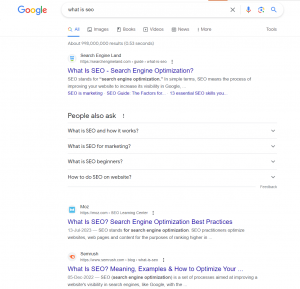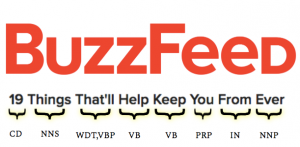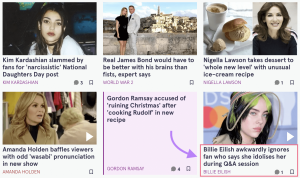
We all love catchy headlines, don’t we? There’s just something about those headlines that makes us want to click them on the SERP. It doesn’t matter if it is a pasta recipe or eyeliner technique, any title that catches our attention has to be looked at. While the love for a good headline is unanimous, curating one needs a certain level of thinking blended with creativity—combine them together, and you have an ideal SEO headline that takes your page’s CTR through the roof.
The importance of headlines that stand out
Here is the snapshot of a Google search results page:

The user who’s searching for results has only two things to look at before they make up their mind to click on the link: the title and the meta description.
Having the right words in these two places would impact the CTR on your link. A headline that perfectly matches the users’ search intent has three benefits:
Increased click-through rate (CTR): It increases the CTR as more users are enticed to click on the link in search results. According to numbers, on average, 8 out of 10 users will click on the link on the SERP if the title is compelling.
Improved user engagement: Engaging headlines can increase the time users spend on your page. It also leads to lower bounce rates and higher user engagement, all of which are positive signals for SEO.
Enhanced shareability: Compelling headlines are more likely to be shared on social media, which can bring additional traffic and backlinks, further improving SEO.
How to write a compelling SEO headline
Use relevant keywords
Finding keywords for writing SEO-friendly headlines involves a systematic process that combines research, analysis, and creativity.
It starts with knowing the search intent of your target audience. Let’s pause here and understand search intent.
Backlinko explains search intent as:
“The main goal a user has when typing a query into a search engine. Common types of Search Intent include informational, commercial, navigational, and transactional.”
For example, if someone has a leaky faucet and they want to get it fixed quickly, they’d look for plumbing services in their vicinity. They’d search for something like “plumbing services near me”.
Now, any plumbing company knows their audience is looking for a list of services, and they want it in their area. They have to find relevant keywords that match this search intent and come up with a compelling SEO headline.
After getting an understanding of the search intent, the next step is to find relevant keywords to create a compelling title.
Start by logging in to any keyword research tool and look for data on search volume, competition, and related keywords. There are several tools like Google Keyword Planner, Ubersuggest, SEMrush, Ahrefs, Moz’s Keyword Explorer, etc.
Begin with a few seed keywords related to your topic. These are broad terms that are relevant to your content. For example, if you’re writing about “digital marketing,” your seed keywords might be “online marketing” and “internet advertising.”
In the next step, enter your seed keywords into the tool. It will generate a list of keyword ideas based on search queries and trends. Review the list and consider keywords that are closely related to your topic.
While you do that, pay attention to three things:
Search volume: Higher search volume indicates that more people are searching for that term, which can lead to more traffic if you can rank for it. However, also consider your website’s authority and your ability to compete for high-volume keywords.
Keyword difficulty: Evaluate the competition for each keyword. Keyword research tools often provide a metric for keyword difficulty or competition level. Choose keywords that have a reasonable level of competition, especially if your website is not highly authoritative.
Language and location: Consider the language and location of your target audience. Local businesses, for example, should focus on keywords relevant to their geographic area.
After selecting your target keywords, create a keyword mapping plan. Determine which keywords will be used in the headline, meta description, subheadings, and throughout the content.
Writing catchy titles
A catchy and SEO-friendly headline requires a blend of creativity and strategic thinking. It needs to have two basic elements: the right words and perfect framing. They both combine to form a headline that gets the clicks. For example, ‘camping gear’ is the perfect keyword for someone looking for items to take on a camping trip. But ‘Essential camping gear to take on your first campout as a beginner’ is a perfect SEO headline example as it catches the attention for two reasons. The first is the use of the power word “essential”. It shows the content has a list of items that you must take on the trip. In the last part, the headline really specifies its target audience: beginners. We all know camping as a beginner can be stressful, so any first-timer looking for some advice knows this content is for them.
Making headlines enticing and intriguing to pique the reader’s interest is also a way to get more clicks. This is done by adding power words.
Power words are emotionally charged words that evoke strong reactions in readers. They are used to create a sense of urgency, curiosity, excitement, or desire. Examples of power words include “ultimate,” “amazing,” “essential,” “proven,” “exclusive,” “guaranteed,” and “breakthrough.” Incorporating power words in the headline can make it more compelling.
We all know BuzzFeed. Their whole business is curating punchy headlines and getting clicks. They are the best when it comes to using power words in headlines and have the best SEO headlines examples.

Superlatives like “best,” “top,” “most,” and “greatest” can also make your content seem authoritative and appealing. They suggest that your content is superior to others. Asking a question in your headline can engage readers and make them curious to find the answer. Use question words like “what,” “why,” “how,” and “when” for this purpose.
While writing an SEO headline, the trick is to frontload your keywords and incorporate them naturally. Search engines often give more weight to the first few words of a title, and they absolutely hate the stuffing of keywords.
Using numbers and listings
Numbers and listing are a proven way of catching the audience’s attention as people tend to click on headlines with numbers because they suggest a clear and organized structure.
Users are often looking for information that they can quickly and easily consume. Headlines with numbers and listings suggest that the content will be easy to read and scan, which makes it more appealing to people who are short on time. For example, the headline “5 ways to upgrade instant ramen noodles!” is more likely to get clicks than the headline “how to add more value to your ramen noodles.”
Headlines with numbers and listings are also more visually appealing. They stand out from the other headlines on the SERP and make it easier for people to scan and find the information they are looking for.
Such content is often more shareable on social media. Users find it easier to share content that they can describe concisely, such as “check out these 5 incredible marketing strategies!” This can lead to increased visibility and clicks.
Length optimization
Google SERP has a limited amount of space for headlines, and headlines that are too long will be truncated. This means that users will not be able to see the entire headline, which can make it difficult for them to understand what the content is about and whether it is relevant to their search query.
According to a study by Moz, the most common length of titles displayed in Google SERPs is under 60 characters. This means that headlines that are around 60 characters long are most likely to be displayed in full and are also most likely to be relevant to the search query.
A well-optimized headline that stays within the character limit is more likely to get clicks on mobile phones. With the increasing use of mobile devices for online searches, shorter headlines are particularly important. Mobile screens have limited space, and a concise, well-optimized headline is more likely to fit on the screen, ensuring that users can quickly grasp the content’s relevance.
Integrate local SEO
It is an open secret that Google prioritizes local SEO. Optimizing your SEO headings with location-specific keywords can increase the chances of appearing in the local results and attracting more clicks from customers looking for a product or service in their area.
For example, if you are a plumber in Denver, you might use the headline “24/7 plumber in Denver” in your content’s headline.
The phrasing of 24/7 is important to focus on because when people search for local businesses or services, they are often looking for specific information, such as hours of operation, location, or contact information. By including this information in your headlines, you can make it clear to searchers that your content is relevant to their needs.
Avoid clickbait
Clickbait used to work ten years ago, but not anymore. Search algorithms absolutely despise clickbait headlines as they now want to provide users with the most relevant and informative results possible. Clickbait headlines are often misleading and sensationalized, and they can direct users to click on results that are not actually relevant to their needs.
Clickbait also damages a website’s credibility. A misleading headline can often lead to users having a negative experience on the target website. If a user clicks on a clickbait headline and is then taken to a website that does not deliver on the promise of the headline, they are likely to be disappointed and leave the website quickly. This can lead to high bounce rates and low dwell times, which are both negative signals to search engines.
Final Thoughts
Getting your SEO headlines right is absolutely vital to get clicks on your link in the SERP. The challenge is to craft the most compelling and attention-grabbing title in just 60 characters. The ingredients of a perfect headline that attracts clicks like a magnet are ideal keywords, right phrasing, listing and numbers, local SEO optimization, and not a single speck of clickbait.